January 2024
Pencils Down!
 This is what my examination proctors would say when the allotted time for Educational Testing Service PSAT’s, SAT’s and other similar tests had elapsed. I recall the same call being used in college when sitting for various mid-terms and finals. This is what my examination proctors would say when the allotted time for Educational Testing Service PSAT’s, SAT’s and other similar tests had elapsed. I recall the same call being used in college when sitting for various mid-terms and finals.
Now, there’s a different, more generational, meaning to the phrase in the field of Architecture. Actual drafting of pencil on paper is a nearly dead art. I must admit I’m saddened by its passing.
Arch's Adolescence
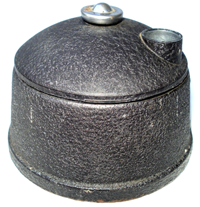 As a young lad, in high school, I had two years of “mechanical drawing” (“Drafting”, if you will) – The kind of thing you did with T-Squares, triangles, and leadholders (definitely NOT pencils) to place lines on vellum paper. Proper technique was essential. As a young lad, in high school, I had two years of “mechanical drawing” (“Drafting”, if you will) – The kind of thing you did with T-Squares, triangles, and leadholders (definitely NOT pencils) to place lines on vellum paper. Proper technique was essential.
- The lead had to be carefully sharpened to a conical point using a rotary sharpener.
- When placing the linework on vellum, holding the leadholder at the proper angle was important, since the lead had to be dragged rather than pushed as you drew.
- As the leadholder was moved across the drawing, it had to be slowly twirled, so that the point of the lead stayed symmetrical with no flat spot, and the lineweight remained consistent.
- Varying lineweights required manual dexterity - thin delicate lines for some details, and broad dark lines for others. You had to learn how to make multiple passes or use different hardnesses of graphite to achieve proper results.
Even all this was an evolution, as the “old timers” of that day were accustomed to drafting with pen and ink on coated cloth vellum. That, too, was part of my curriculum; and my drafting sets had holders and compasses that held either short pieces of lead or adjustable nibs for laying down India ink linework.
Tools
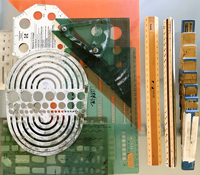 You can tell craftsmen by their tools – says the guy who has been known to pound a tack with the heavy end of a screwdriver. All those lines, of course, are not freehand drawn. An enormous array of equipment is needed to get things done elegantly. Even the means of erasing mistakes required finesse. You can tell craftsmen by their tools – says the guy who has been known to pound a tack with the heavy end of a screwdriver. All those lines, of course, are not freehand drawn. An enormous array of equipment is needed to get things done elegantly. Even the means of erasing mistakes required finesse.
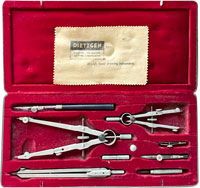 This is from the old stash of drafting equipment – now ancient artifacts. This is from the old stash of drafting equipment – now ancient artifacts.
I must admit to some nostalgia here. I still have my first set of the “World’s finest drawing instruments”. I can’t open it up without resurrecting the fond memory of Mr. Karl Czirr, my high school mechanical drawing teacher, who gave it to me as I went off to college, entering the McGill University School of Architecture. His training was my foundation.
Lettering
Hand lettering was expected to be uniform and legible, carefully constructed between faint horizontal guidelines. When I started, you had to decide where you stood on the debate between slanted versus vertical lettering. The old guard liked slanted. Newcomers and budding architects preferred vertical.
Learning to letter well was not easy. To improve, I devised a plan; and stopped writing in cursive, printed everything. Mostly I printed in upper case. But I developed personal fonts for both upper and lower case that I came to rely on.
For drawings where appearance was important, I refined a lettering technique using a chisel-point sharpened lead that I would guide with an inverted small triangle below a T-Square, parallel bar, or drafting machine.
Anecdote: I got one of my summer jobs working for a civil engineering and landscape architecture firm by acing the first step of the interview. The owner (an “old timer” to say the least) had a strategy. His standard job application form required the answers to be hand printed. If he liked what he saw, he would talk to you. Yes, I was hired – for what was an extremely expansive growth experience. The seasoned staff was very kind to me. My reward for learning how to letter.
Mylar
Eventually paper or vellum medium gave way to the more durable mylar sheets often seen today. Graphite lead didn’t lay down well on mylar, with inconsistent line weight and a tendency to smudge. Enter plastic leads – still held in the same old reliable leadholders. Plastic “feels” very different form the older graphite leads, requiring some getting used to. But eventually it became second nature. Still old school though.
Pin Bar and Photo Drafting
Somewhere along the way, people finally realized that there was a lot of unproductive repetition in architectural drafting.
- Floor plans that would be drawn from scratch for each variable use architectural, engineering, furniture, reflected ceiling, etc.
- Border and title information that was duplicated for every sheet in a set of contract documents.
- Standard details which repeated from one project to the next.
- Standard notes, legends, and disclaimers that were inserted into all contract document sets.
Pin Bar drafting was the method of that day. Along with the use of photo and copy machine reproductions, reiterative drafting was significantly reduced. Reproduction techniques, however, arguably became significantly more complicated. The method also established the mindset of layering the information, which turned out to be useful when CADD started its intrusion into our business. But, those are topics for different newsletters.
While the amount of drafting may have been reduced, the media were not – still plastic lead on mylar. Sometimes embellished with ink, for emphasis.
What? New Pencils?
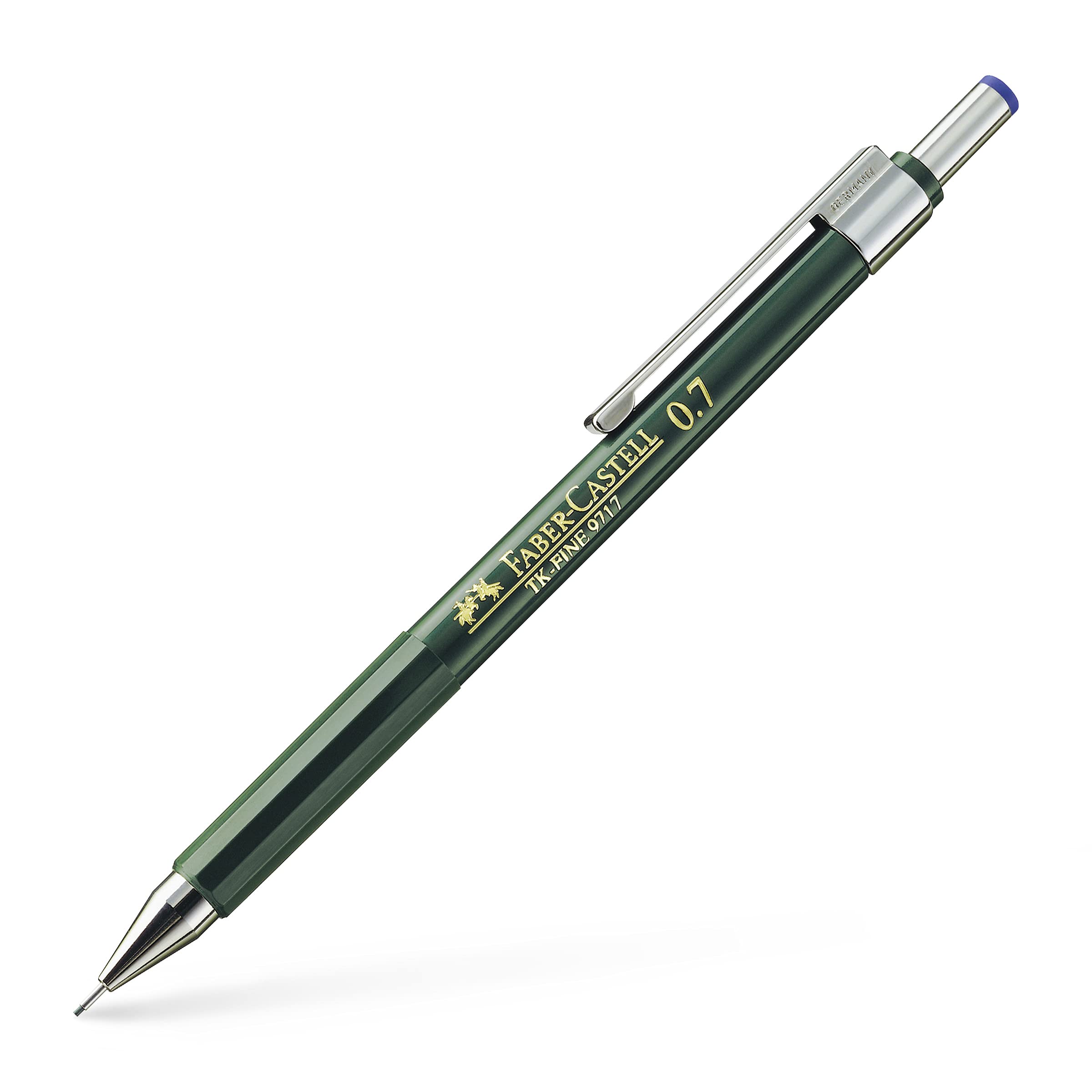 I don’t know for sure what instigated the change. I suspect as a group drafters were getting lazy, and hated the regimen of sharpening and chiseling the lead in their leadholders. Whatever. I don’t know for sure what instigated the change. I suspect as a group drafters were getting lazy, and hated the regimen of sharpening and chiseling the lead in their leadholders. Whatever.
We now were asked to consider new mechanical leadholders (OK, pencils). Eventually, I was won over, albeit with some sadness as I left behind the artistry of years of practice with lead types, sharpeners, and sandpaper boards.
Ink
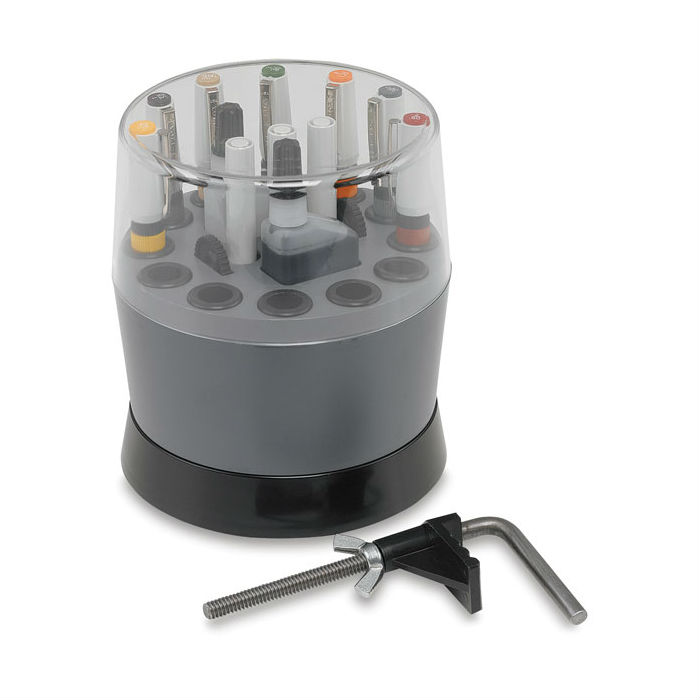 Being a child of post-war America, I came into architecture after the intervention of technical pens ala Rapidograph. Even so, my beam compasses and tools in the drafting set has removable calipers. Being a child of post-war America, I came into architecture after the intervention of technical pens ala Rapidograph. Even so, my beam compasses and tools in the drafting set has removable calipers.
Rapidographs were hateful. Constantly clogging, with a habit of unexpectedly dumping ink that would flow under the straightedge you might be using to draw the lines. Then there were the lettering stencils – more Rapidograph agony.
Yes, I could do it (both calipers and Rapidograph); and yes, I still have the hardware and cleaning equipment. But, like the array of leadholders, they gather dust.
This is what Wikipedia offers on the subject: “While the Rapidograph style of pen is still widely used by artists, the use of computer-aided design (CAD) has largely replaced the need for manual drafting. Also, the development of felt-tip, ink-based pens has provided cheaper, lower-maintenance disposable tools that sell much better than traditional technical pens.”
It Used To Be Physical 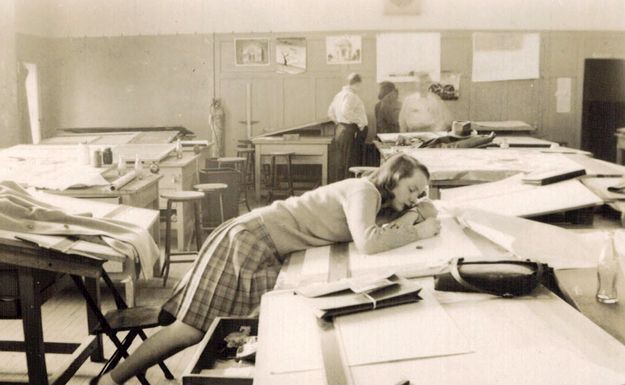 Drafting required movement and agility, especially with stool-height drafting tables. You were all over the board – sometimes even on top of it when something had to be placed in awkward locations. Linework at the top of the page, or vertical handlettering was not always easy. A far cry from the sedentary milieu of most offices today. Too bad. Drafting required movement and agility, especially with stool-height drafting tables. You were all over the board – sometimes even on top of it when something had to be placed in awkward locations. Linework at the top of the page, or vertical handlettering was not always easy. A far cry from the sedentary milieu of most offices today. Too bad.And Then Comes CADD, Followed By BIM
Eventually, as we all know, computers made the artistry of the hands-on die its eventual death. Now drafters can create superb linework of architectural errors faster than a team of humans could ever do.
The evolution has been fascinating. From digital files sent to plotters used to create line drawings that were printed on translucent paper useful for Ozalid printing - to the current use of fully digital media common today. The early migration of Intergraph from the aerospace industry to architecture was so expensive that design firms had to use two shifts per day to amortize the cost of hardware and software. Quite the challenge. Yet another newsletter maybe.
Life Goes On.
All this conversation, for me, lines up with a similar story of how we drive cars. The pleasure of operating a manual transmission vehicle has gotten harder to preserve. So too with the satisfaction of skillfully using the “tools of our trade”. Call me a curmudgeon. Perhaps this is one reason why I stubbornly hang on to my hand sketching and gridded tracing paper drafting of furniture projects.
How do you cope?
Missed earlier newsletters? Find them here:
August 2023 “Carpentry Therapy"
March 2023 “When? please tell me when"
September 2022 “
The New Normal"
March 2022 “
Facilities Management – My Way"
January 2022 “Report Writing for Dummies"
October 2021 “Writer's Block and Other Musings"
May 2021 “Lower Ed?”
September 2020 “Just Stylin'”
July 2020 “Reflections on Our Covid Times”
February 2020 “Quirky Clients – The Smart Version”
September 2019 “OPM Cheerleader”
June 2019 “Can You Perform?”
February 2019 “Today's Word”
October 2018 “The Case for DIversity-Architect's Version”
June 2018 “A Capital Idea”
March 2018 “Me Too?”
January 2018 “R U Trending?”
October 2017 “Do You Measure Up?”
August 2017 “I'm an Architect and I'm Here to Help”
January 2017 “The Future of Higher Education”
November 2016 “The Owner as CM?”
August 2016 “Don't you just hate...”
June 2016 “Duck Testing”
April 2016 “Once Upon a Time...”
January 2016 “I want to take you higher”
November 2015 “Moderating in all Things?”
July 2015 “Alphabet City”
May 2015 “Acey Trey Trey Trey?”
January 2015 “Nature or Nurture?”
August 2014 “Acey Trey Trey?”
June 2014 “The Seven Deadly Sins”
March 2014 “Thar She Blows!”
November 2013 “Giving Thanks”
September 2013 “Back to School?”
June 2013 “What Time is It?”
March 2013 “Acey Deucey?”
January 2013 “A Swamp Full of Alligators”
October 2012 “Plan to Live Forever, Part Deux”
July 2012 “A Midsummer Dream”
May 2012 “Are you Virtually Working?”
March 2012 “Your Huddled Masses”
January 2012 “Observing Observations”
October 2011 “I Want What I Want”
August 2011 “A Beach Read”
May 2011 “NeoLuddite or Technophile?”
March 2011 “Do Your Silos Leak?”
January 2011 “Plan to Live Forever!”
November 2010 “May I Have A Plan, Master?”
September 2010 “How do we choose?”
July 2010 “Good People Behaving Badly”
May 2010 “LEED: LEADing or Dead Weight?”
March 2010 “Why does it cost so much?”
January 2010 “Design/Builders show us your softer side.”
November 2009 “What the Facilities?”
September 2009 “Why Do Architects Make Good Owner’s Reps?” |
 Drafting required movement and agility, especially with stool-height drafting tables. You were all over the board – sometimes even on top of it when something had to be placed in awkward locations. Linework at the top of the page, or vertical handlettering was not always easy. A far cry from the sedentary milieu of most offices today. Too bad.
Drafting required movement and agility, especially with stool-height drafting tables. You were all over the board – sometimes even on top of it when something had to be placed in awkward locations. Linework at the top of the page, or vertical handlettering was not always easy. A far cry from the sedentary milieu of most offices today. Too bad.
 This is what my examination proctors would say when the allotted time for Educational Testing Service PSAT’s, SAT’s and other similar tests had elapsed. I recall the same call being used in college when sitting for various mid-terms and finals.
This is what my examination proctors would say when the allotted time for Educational Testing Service PSAT’s, SAT’s and other similar tests had elapsed. I recall the same call being used in college when sitting for various mid-terms and finals. As a young lad, in high school, I had two years of “mechanical drawing” (“Drafting”, if you will) – The kind of thing you did with T-Squares, triangles, and leadholders (definitely NOT pencils) to place lines on vellum paper. Proper technique was essential.
As a young lad, in high school, I had two years of “mechanical drawing” (“Drafting”, if you will) – The kind of thing you did with T-Squares, triangles, and leadholders (definitely NOT pencils) to place lines on vellum paper. Proper technique was essential. You can tell craftsmen by their tools – says the guy who has been known to pound a tack with the heavy end of a screwdriver. All those lines, of course, are not freehand drawn. An enormous array of equipment is needed to get things done elegantly. Even the means of erasing mistakes required finesse.
You can tell craftsmen by their tools – says the guy who has been known to pound a tack with the heavy end of a screwdriver. All those lines, of course, are not freehand drawn. An enormous array of equipment is needed to get things done elegantly. Even the means of erasing mistakes required finesse. This is from the old stash of drafting equipment – now ancient artifacts.
This is from the old stash of drafting equipment – now ancient artifacts. I don’t know for sure what instigated the change. I suspect as a group drafters were getting lazy, and hated the regimen of sharpening and chiseling the lead in their leadholders. Whatever.
I don’t know for sure what instigated the change. I suspect as a group drafters were getting lazy, and hated the regimen of sharpening and chiseling the lead in their leadholders. Whatever.  Being a child of post-war America, I came into architecture after the intervention of technical pens ala Rapidograph. Even so, my beam compasses and tools in the drafting set has removable calipers.
Being a child of post-war America, I came into architecture after the intervention of technical pens ala Rapidograph. Even so, my beam compasses and tools in the drafting set has removable calipers.